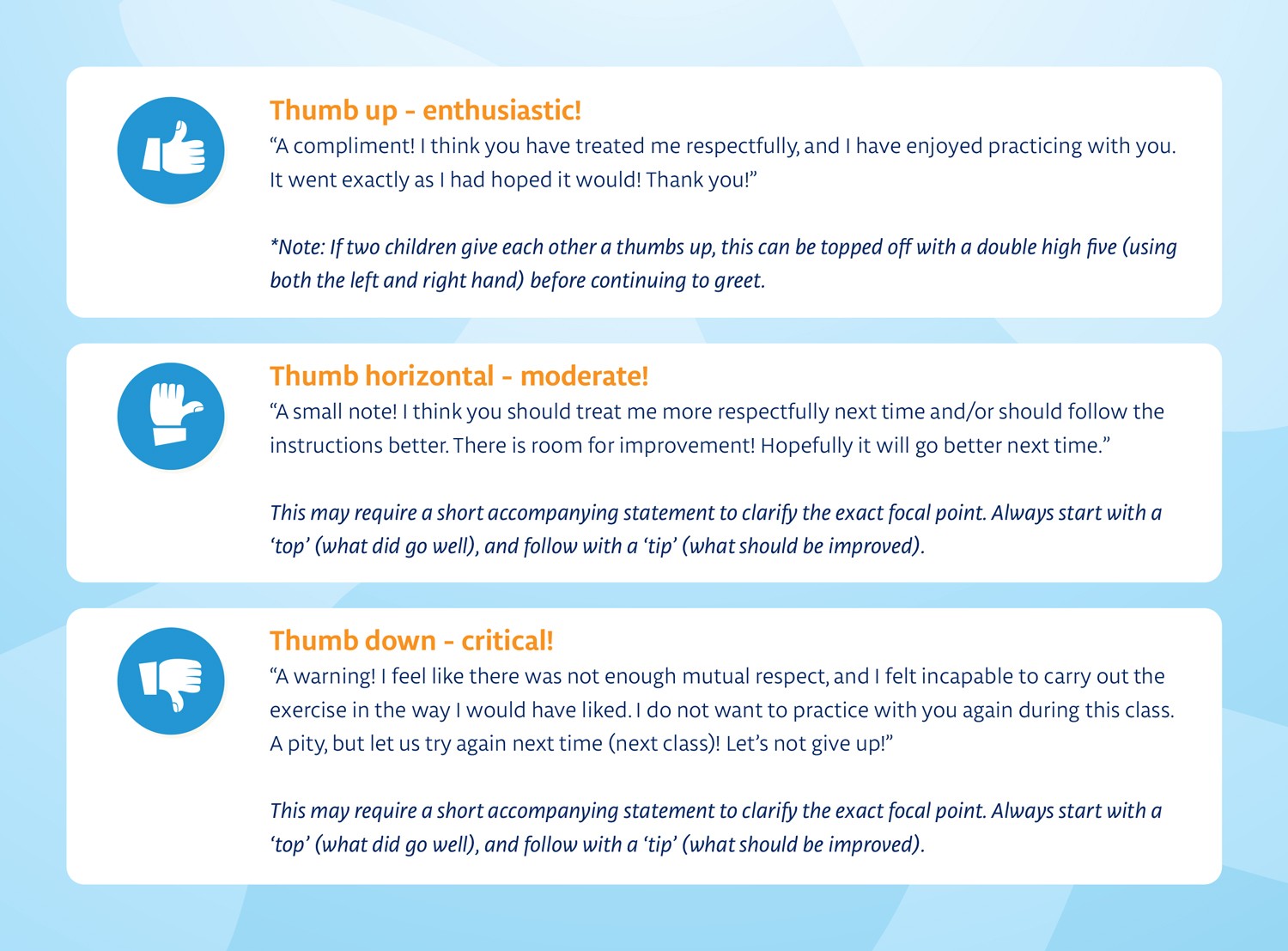The thumbs feedback method
The thumbs feedback method originated from Schooljudo The Netherlands and is developed by Yos Lotens, judo teacher, educator and writer of several judo books. The method has received lots of positive feedback and is often implemented outside of the judo lessons as well.
The thumbs feedback method has three main purposes:
- Learn to reflect.
- Learn to express yourself, and how you experience an exercise or a class.
- Learn to compliment yourself and others, and to receive compliments.
How does it work?
As the teacher, you indicate that the next exercise will directly be followed by a moment of reflection, in which you will give each other a thumb. You count ‘1, 2, 3…. THUMBS!’, and everyone shows a thumb (up, down, or halfway) at the same time. How you hold your thumb, indicates whether:
- Everyone worked together respectfully, taking into consideration each other’s strengths and limitations.
- The exercise was performed as intended, and everyone practiced and played as had been agreed upon. Directly after showing each other the thumbs, you greet. From experience, we know that this manner of direct feedback, combined with success stories, positive reinforcements, and the involvement of exercise buddies, has a motivating effect.
Reflection during group activities
Reflection is also an important tool for learning during or after group activities. It advances the pedagogic climate, and improves and speeds up the learning process. It also allows children to give their input for the rules of the game. Suggestions they may have, can be put to a democratic test by asking questions such as: “How can we make the game more exciting? Which rule needs to be adjusted, added, or removed?” This way, a game can work much better for one group than for another. The challenge for the Entertainer or teacher is to explore the boundaries of the group, and to decide what will foster growth. Extra tip: the thumb can be used in many ways. Let children use their thumb to indicate how they feel at the start of a class. This will let you know straight away whether there’s someone you just need to ‘leave be’ for today. You can use your thumb for non-verbal reinforcement. Be as specific as possible, maintain eye contact whilst giving the thumbs up, and explain what you thought went well.
Using the index finger
Index finger - thumb Briefly point your index finger(s) at the student, quickly retract, and give a thumbs up with the same hand straight away. One hand compliments a specific judoka, two hands compliment a duo.
Pat on the back - For self-confidence, confirmation, giving and receiving compliments
A pat on the back for yourself Crossing your arms on your chest, pat yourself on the back/shoulders twice, then directly turn both thumbs upwards. -because you are proud of yourself for having done well. A pat on the back for someone else Crossing your arms on your chest, pat yourself on the back/shoulders twice, then stretch your arms out in front of you and turn both thumbs upwards, then point to the person(s) you are complimenting.
- One shoulder knock for another;
- A pat on the shoulder for the group.
Note: children need to feel safe when giving a thumb. Never disapprove of them giving a thumbs down. Do not engage straight away, but discuss is with the respective child in private, for example during the next exercise (delayed attention). This way, the student will get the attention (s)he deserves, whilst avoiding that children will give a thumbs down just to attract instant attention. You also avoid slowing down your class.
The red belt method
Involving the kids: The Red Belt Method
The Red Belt Method originated from Saint Genevieve Sport Judo Club in France. The purpose of this method is to try to get the students attention and to motivate them to overcome their weaknesses and to become better children.
Throughout the year, you have one (or more) red belts in your possession. You will explain the children that in the end of each lesson, you will give the Red Belt as a reward.
The criteria to get the belt is easy. Pay attention in the class, help your friends if they need it, don’t make noise, put your hand up before you speak, say thank you, good job, be respectful, etc. In other words, apply the values of judo during the lesson.
The child who gets the belt in the end of the lesson will be able to sit next to you in the end of the lesson, and the next lesson at the start (he/she will also keep the belt in his possession during the whole lesson). At the end of the lesson, he/she will help you to give the belt to another child.
The ritual:
- In the end of the lesson, all the children are in the position for the zarei.
- The teacher picks one (or more) of the children. The child will come to you, while the other children give an applause because he/she did a good job that day.
- The child will stay next to you and do the bow together with you.
- After the bow the child stays with you. All the other children form a train (line) and will one by one shake your hand and the hand of the child with a red belt, before leaving the tatami.
With this exercise you involve the children. You give them responsibility and possibility to help you to make a choice.
Try to make sure at the end of the year that every child received the Red Belt at least once. Motivate him/her to choose the child that was the best example of using the values and not one of his/her friends.
This method will help them not only to apply the values on each lesson, but also to give them extra motivation to attend and participate in the classes.




